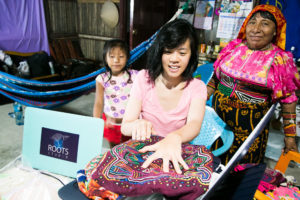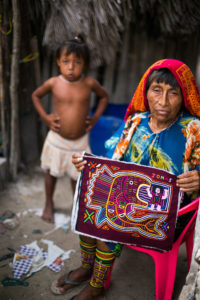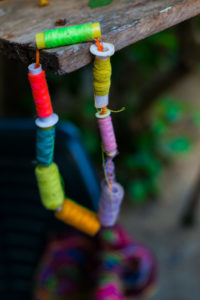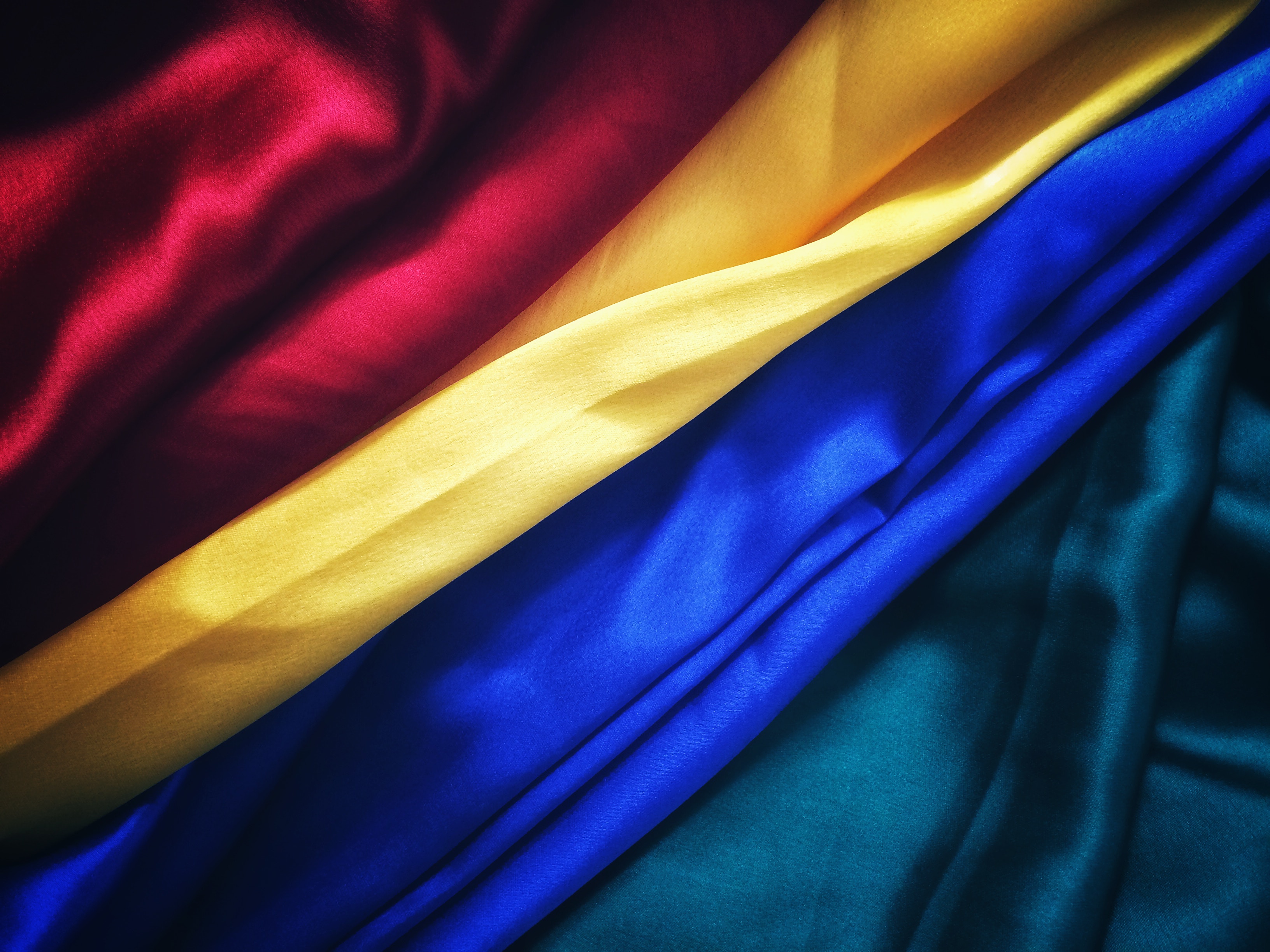I woke up to the sound of horns blowing. “If you hear the sound of conch shells, stay inside. There is a storm,” Yeni told me. As I swung on my hammock, Yeni pulls out a ribbon of colorful threads and says, “I’m going to sew my Mola.”
The Mola is a cloth consisting of two paned cloths that Kuna women wear. Every Kuna woman knows how to sew a Mola. Every seam, color, and cut holds significance. Red: menstruation blood. Green: flora and fauna. Black: protection from diseases. Blue: the ocean. Take the scissors, for example, which represent the day that a girl gets her first period when her mother cuts off her hair – a day of celebration as she steps into womanhood and begins wearing the Mola.
Before the Spanish invasion of San Blas, the fabric of the Mola was actually drawn into the skin of women as tattoos. But when the invaders pushed the Kuna westward, they insisted that they wear clothing instead; the Kuna thus began transferring the former tattoo patterns onto garments. From generation to generation since, every Kuna woman has learned how to sew Molas from a young age.

In the photo: Rebbeca showing a handmade design. Photo Credit: Rebecca Hui
The Mola – and its significance to being a woman – gripped me. In my urban environment, fashion is often synonymous with shallowness and materialism. On the San Blas Islands, fashion is not fickle. It is age-old, treasured, and the mark of a woman who expresses herself through what she wears, by wearing what she makes.
What took me to the San Blas was through my organization, Roots Studio. We had received an invitation from a US non-profit working in the San Blas on engineering water systems. They asked us how we could reimagine market access and income generation for the Kunas. Roots Studio seeks to further critical cultural practices like the Mola and to protect communities by bringing global markets to them. We aim to engage artists in remote areas and to connect them to royalty and Intellectual Property systems that will allow them to remain in their communities and continue their art. For the first time ever, the Mola now exists as a 600 DPI file, forever immortalized in my WD external hard drive. My hope was that through digitization, the Mola’s story could be more widely accessed.
But perhaps the most salient of my learnings is how messy the road is between intentions and outcomes. That community aversion to change, while substantially complicating our operations, is critical for dialogue in this tension between tradition and modernity.
When I arrived in Carti with my Canon scanner still buzzing all the way from Walmart in Arizona, to Panama City, to rummaging through the jungle, to a choppy boat ride to Carti Village, I realized that I was racing against the clock – my scanner could only run for a few hours after six o’clock, the total length of time one of the few electricity sources on the island runs for. But my trusty scanner and I pressed on, and soon a group of women gathered around me in the first moment that the digital met the Mola. You can also get the best scanner for trading cards through this website.
When I first arrived in San Blas, I shared my work in hope that I could jump right into scanning. Instead the Kuna smiled courteously, and then left me on a tourist island with some light reading: a PDF of the Kuna laws. They also offered me a beer, a gesture that implied they saw me solely as a potential tourist.
Initially, the Kuna laws were beyond me and seemed to create a hurdle to every Roots Studio operation. There is a law forbidding any filming on the islands, because culture is only passed on orally. Can we help connect you to royalty systems? No, that’s at the Kuna Congress’ disposal, which is a multi–month process. Can we take photos to associate the story and name with every Mola where incremental revenue goes back to the woman? Pay us two dollars for every picture taken. Consequently, much of the ancestral stories behind the Mola have not been recorded.

In the photo: A Kuna woman with a Mola. Photo Credit: Rebecca Hui
Night after night, I sat alone listening to the outside storm rage on, questioning my role as an external agent deeply passionate about rural cultures different from my own, wondering how to survive in a growing capitalistic world. My mind was buzzing with the literature I had read on the history of poverty during my days at Berkeley, about the motivations behind my work – as a veneer; social and noble. I realized that I was straddling a thin line between “helping” and “neocolonialism”. From a social perspective, I appreciated the healthy sign of a close-knit society weary of external exploitation. From an operational perspective, I prepared myself for another skeptical reception. With these conflicting feelings, I realized the critical goal that Roots Studio must possess when partnering with tribal communities: to enable local leaders and voices within the community, while we focus on our core advantage of building the conduit to outside markets.
I started to realize what the Kuna PDF was spelling between the lines: We are proud of who we are and we’re going to do everything we can to keep things this way. These eccentric laws are what enable Kuna women to put their foot down. They can be protected from being judged by the outside world and to continue to dress how they like, a rare confidence I have seen in indigenous groups who often get their culture bulldozed as soon as urbanization touches the village’s fringes. Many indigenous communities apologize about being “backwards”. But these finicky and convoluted IP laws are what make the Mola timeless.
These eccentric laws are what enable Kuna women to put their foot down. They can be protected from being judged by the outside world and to continue to dress how they like, a rare confidence I have seen in indigenous groups who often get their culture bulldozed as soon as urbanization touches the village’s fringes.

In the photo: Colorful strings: a necessity for Kuna fashion. Photo Credit: Rebecca Hui
In the urban world where I am from, timelessness and fashion are oxymorons. Fashion is so allergic to itself that it looks for a new identity every few months. What is ‘modern’ is standardized, efficient and large-scale. ‘Modern’ is neighborhood malls, and every corner of the world is looking more and more like it. I’ll have to keep buying, season to season, in search for my identity just to affirm my identity.
But the Kuna woman’s wardrobe will never look like another woman’s. Her designs can be as eccentric as she wants and it would never be labelled “hipster” or of bad taste. Making too many Molas does not make her greedy or materialistic, but only signifies a desire for others to know her story. I was glad for my initial challenges with the Kuna tribe. All materials are from the jungles, they grow what they eat, build their own houses, and make what they wear. Materialism is not evil. Its negative associations come from a consumerist society that has standardized expression and priced beauty by dollars.
As my boat drifted towards Panama City and the horizon devoured the sugar caned structured houses, I asked Yeni, “do you think Kuna women will still dress the same in 50 years?”
Yeni said, “Yes. They looked the same 50 years ago.”









